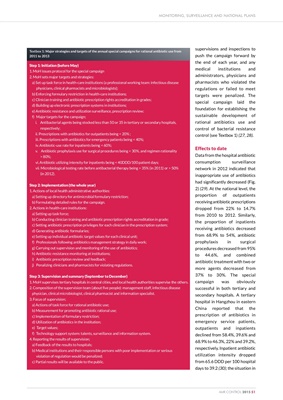
supervisions and inspections to
push the campaign forward by
the end of each year, and any
medical institutions and
administrators, physicians and
pharmacists who violated the
regulations or failed to meet
targets were penalized. The
special campaign laid the
foundation for establishing the
sustainable development of
rational antibiotics use and
control of bacterial resistance
control (see Textbox 1) (27, 28).
Effects to date
Data from the hospital antibiotic
consumption surveillance
network in 2012 indicated that
inappropriate use of antibiotics
had significantly decreased (Fig.
2) (29). At the national level, the
proportion of outpatients
receiving antibiotic prescriptions
dropped from 22% to 14.7%
from 2010 to 2012. Similarly,
the proportion of inpatients
receiving antibiotics decreased
from 68.9% to 54%, antibiotic
prophylaxis in surgical
procedures decreased from 95%
to 44.6%, and combined
antibiotic treatment with two or
more agents decreased from
37% to 30%. The special
campaign was obviously
successful in both tertiary and
secondary hospitals. A tertiary
hospital in Hangzhou in eastern
China reported that the
prescription of antibiotics in
emergency service patients,
outpatients and inpatients
declined from 58.4%, 39.6% and
68.9% to 46.3%, 22% and 39.2%,
respectively. Inpatient antibiotic
utilization intensity dropped
from 65.6 DDD per 100 hospital
days to 39.2 (30); the situation in
MONITORING, SURVEILLANCE AND NATIONAL PLANS
AMR CONTROL 2015 51
Textbox 1: Major strategies and targets of the annual special campaigns for rational antibiotic use from
2011 to 2013
Step 1: Initiation (before May)
1. MoH issues protocol for the special campaign
2. MoH sets major targets and strategies:
a) Set up task force in health-care institutions (a professional working team: infectious disease
physicians, clinical pharmacists and microbiologists);
b) Enforcing formulary restriction in health-care institutions;
c) Clinician training and antibiotic prescription rights accreditation in grades;
d) Building up electronic prescription systems in institutions;
e) Antibiotic resistance and utilization surveillance, prescription review;
f) Major targets for the campaign;
i. Antibacterial agents being stocked less than 50 or 35 in tertiary or secondary hospitals,
respectively;
ii. Prescriptions with antibiotics for outpatients being < 20% ;
iii. Prescriptions with antibiotics for emergency patients being < 40%;
iv. Antibiotic-use rate for inpatients being < 60%;
v. Antibiotic prophylaxis use for surgical procedures being < 30%, and regimen rationality
> 80%;
vi. Antibiotic utilizing intensity for inpatients being < 40DDD/100 patient days;
vii. Microbiological testing rate before antibacterial therapy being > 35% (in 2011) or > 50%
(in 2012).
Step 2: Implementation (the whole year)
1. Actions of local health administrative authorities:
a) Setting up directory for antimicrobial formulary restriction;
b) Formulating detailed rules for the campaign.
2. Actions in health-care institutions:
a) Setting up task force;
b) Conducting clinician training and antibiotic prescription rights accreditation in grade;
c) Setting antibiotic prescription privileges for each clinician in the prescription system;
d) Generating antibiotic formularies;
e) Setting up individual antibiotic target values for each clinical unit;
f) Professionals following antibiotics management strategy in daily work;
g) Carrying out supervision and monitoring of the use of antibiotics;
h) Antibiotic-resistance monitoring at institutions;
i) Antibiotic prescription review and feedback;
j) Penalizing clinicians and pharmacists for violating regulations.
Step 3: Supervision and summary (September to December)
1. MoH supervises tertiary hospitals in central cities, and local health authorities supervise the others.
2. Composition of the supervision team (about five people): management staff, infectious disease
physician, clinical microbiologist, clinical pharmacist and information specialist.
3. Focus of supervision;
a) Actions of task force for rational antibiotic use;
b) Measurement for promoting antibiotic rational use;
c) Implementation of formulary restriction;
d) Utilization of antibiotics in the institution;
e) Target values;
f) Technology support system: talents, surveillance and information system.
4. Reporting the results of supervision;
a) Feedback of the results to hospitals;
b) Medical institutions and their responsible persons with poor implementation or serious
violation of regulation would be penalized;
c) Partial results will be available to the public.